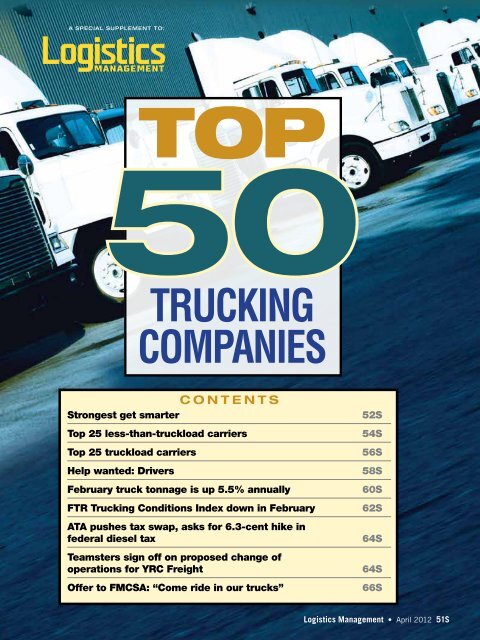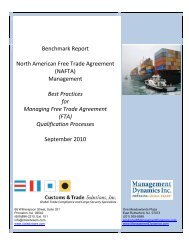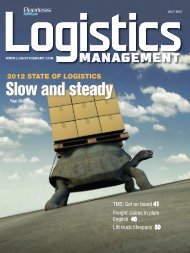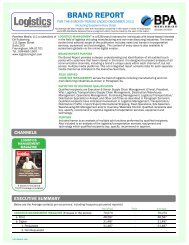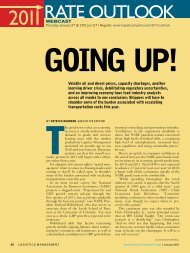Top 50 Trucking Companies - Logistics Management
Top 50 Trucking Companies - Logistics Management
Top 50 Trucking Companies - Logistics Management
You also want an ePaper? Increase the reach of your titles
YUMPU automatically turns print PDFs into web optimized ePapers that Google loves.
A speciAl supplement to:<br />
TOP<br />
<strong>Trucking</strong><br />
companies<br />
CONTENTS<br />
Strongest get smarter 52S<br />
<strong>Top</strong> 25 less-than-truckload carriers 54S<br />
<strong>Top</strong> 25 truckload carriers 56S<br />
Help wanted: Drivers 58S<br />
February truck tonnage is up 5.5% annually 60S<br />
FTR <strong>Trucking</strong> Conditions Index down in February 62S<br />
ATA pushes tax swap, asks for 6.3-cent hike in<br />
federal diesel tax 64S<br />
Teamsters sign off on proposed change of<br />
operations for YRC Freight 64S<br />
Offer to FMCSA: “Come ride in our trucks” 66S<br />
<strong>Logistics</strong> <strong>Management</strong> • April 2012 51S
Emerging from the three-year freight recession<br />
that slashed freight capacity and rates,<br />
the nation’s top trucking companies view<br />
themselves as innovators, collaborators, technology<br />
leaders, and operational experts—not just as<br />
survivors of the Great Recession.<br />
They also say that they’ve had to be part psychologist<br />
to retain drivers, part soothsayer to try and predict<br />
the future cost of fuel, and part accountant to keep a<br />
keen eye on ever-rising costs wherever possible.<br />
<strong>Trucking</strong> insiders add that although all trucking<br />
companies basically use the same equipment over the<br />
same highways with the same pool of drivers, the <strong>Top</strong><br />
TOP<br />
<strong>Trucking</strong><br />
companies<br />
Smarter<br />
The nation’s top trucking companies share “high intensity”<br />
management teams, financial stability, and IT systems that afford “twoway<br />
communication” with shippers—and they’re just getting wiser.<br />
52S April 2012 <strong>Logistics</strong> <strong>Management</strong><br />
Strongest get<br />
By John D. schulz, contributing editor<br />
<strong>50</strong> manage to differentiate themselves on many levels.<br />
According to John Larkin, longtime trucking analyst<br />
for Stifel Nicolaus, it starts at the top.<br />
“When management intensity is high the organization<br />
pays attention to the details,” says Larkin.<br />
“<strong>Management</strong> at the <strong>Top</strong> <strong>50</strong> is thinking 3 years to 5<br />
years down the road to make sure that changes in the<br />
market and the industry don’t leave the company up a<br />
creek without a paddle.”<br />
<strong>Logistics</strong> <strong>Management</strong>’s (LM) annual listing of the<br />
nation’s top trucking companies, compiled by leading<br />
trucking analyst firm SJ Consulting, runs the gamut<br />
of size and scope. There are units the likes of UPS
TOP<br />
<strong>Trucking</strong><br />
companies<br />
special report A speciAl supplement to logistics mAnAgement<br />
RANK CARRIER NAME<br />
Freight and FedEx Freight that are subsidiaries of<br />
multibillion corporations; and then there are family-<br />
owned companies such as New England Motor<br />
Freight, a unit of the Shevell Group overseen by<br />
founder, Myron Shevell, a man with six decades of<br />
trucking experience.<br />
But what all of these top operators have in common<br />
is operational excellence. Here’s a look at what’s<br />
making the <strong>Top</strong> <strong>50</strong> run like clockwork, and what<br />
shippers can expect from the best in class.<br />
common denominators<br />
All trucking companies basically utilize the same<br />
trucks with the same population of drivers and run<br />
the same routes. Yet, there are key differentiators<br />
that set the best players apart from the rest. The<br />
54S April 2012 <strong>Logistics</strong> <strong>Management</strong><br />
<strong>Top</strong> 25 Less-THan-TruckLoaD carriers—2011 reVenues<br />
(Includes fuel surcharges)<br />
2011<br />
REVENUE<br />
($MILLION) COMMENTS<br />
1 FedEx Freight $4,710 Combined networks of FedEx Freight and FedEx National LTL<br />
2 Con-way Freight $3,197 Parent company revenues hit record mark of $5.3 billion in 2011<br />
3 YRC Freight $3,183 Formerly YRC National, includes YRC Reimer<br />
4 UPS Freight $2,299 Fastest growing division of UPS in 2011<br />
5 Old Dominion Freight Line $1,732 Most profitable public LTL carrier<br />
6 ABF Freight System $1,681 Profitable in 2011 after losses in 2009 and 2010<br />
7 Estes Express Lines $1,636 Largest private LTL carrier<br />
9 YRC Regional $1,554 Includes Holland, Reddaway, New Penn<br />
8 R+L Carriers* $1,207 Only LTL carrier with title sponsorship of a college bowl game<br />
10 Saia Motor Freight Line $1,030 Launched inside sales division to focus on small shippers<br />
11 Southeastern Freight Lines* $820 Largest private regional LTL carrier<br />
12 Vitran Express $686 Acquired Milan Express in Feb. 2011<br />
13 Averitt Express $557 2012 total company revenue could top $1 billion<br />
14 Roadrunner Transportation $467 Made four acquisitions of non-LTL companies in 2011<br />
15 AAA Cooper Transportation $435 Total company revenues grew 11% to $521 million in 2011<br />
16 Central Transport International $384 Consolidated 30 terminals in network in Nov. 2011<br />
17 New England Motor Freight $336 Division of the Shevell Group of <strong>Companies</strong><br />
18 Dayton Freight Lines* $321 Largest year-over-year growth of private LTL carriers<br />
19 Pitt Ohio Express $305 Member of Reliance Network for national coverage<br />
20 A. Duie Pyle* $267 Opened 15th terminal in Sept. 2011<br />
21 Central Freight Lines* $207 Last formerly public LTL carrier to be taken private<br />
22 Daylight Transport $158 Light-asset with concentration on West Coast<br />
23 Oak Harbor Freight Lines $147 Oldest LTL carrier in the <strong>Top</strong> 25<br />
24 New Century Transportation $145 Light-asset load to ride hybrid LTL operation<br />
25 Wilson <strong>Trucking</strong> $137 Extended direct coverage to parts of Kentucky in Nov. 2011<br />
Total <strong>Top</strong> 25 LTL carrier revenues $27,601<br />
Source: Company reports and SJ Consulting Group estimates. Prepared by SJ Consulting Group, Inc.<br />
Note: Revenue for LTL operations only, unless otherwise indicated<br />
*Revenues primarily LTL and include less than ten percent for truckload<br />
and other services<br />
nation’s leading trucking executives recently opened<br />
up to LM to explain what they do best.<br />
Hank Schmidt, president of Con-way Truckload,<br />
says one common denominator among the<br />
<strong>Top</strong> <strong>50</strong> carriers is certainly their commitment to<br />
safety, among other basics. “It’s the ABCs of doing<br />
things right,” says Schmidt. “That encompasses<br />
compliance, having top-notch equipment, hiring<br />
the best people, all of that.”<br />
<strong>Trucking</strong> analysts comb all aspects of a carrier’s<br />
operation and they say that they see certain values,<br />
an operational culture of excellence, and other expertise<br />
that sets the best apart from the rest. “They all<br />
have great information technology systems because<br />
you can’t manage intensively without the information<br />
to make high quality decisions,” says Larkin.
TOP<br />
<strong>Trucking</strong><br />
companies<br />
special report<br />
RANK CARRIER NAME<br />
And if you dig a little deeper you also find that all<br />
of the <strong>Top</strong> <strong>50</strong> have a culture that accepts and positively<br />
reacts to management intensity. To this point,<br />
Larkin adds that the best trucking companies offer<br />
“customer communication that is a two-way street<br />
in the spirit of collaboration, not the old take-orleave-it<br />
approach under the regulated mindset of the<br />
industry prior to deregulation in 1980.”<br />
Today’s trucking leaders say they have to be part<br />
56S April 2012 <strong>Logistics</strong> <strong>Management</strong><br />
2011<br />
REVENUE<br />
($MILLION) SUBSIDIARIES / COMMENTS<br />
1 Swift Transportation $3,021 Revenue growth driven by +20% increase in dedicated<br />
2 Schneider National $2,600 Includes Schneider National, Schneider National Bulk Carriers<br />
3 Werner Enterprises $1,684 Includes One-way Truckload, Dedicated, and Cross-Border<br />
4 Landstar System* $1,660 Business Capacity Owner revenue only<br />
5 U.S. Xpress Enterprises $1,570<br />
6<br />
Includes U.S. Xpress, Xpress Global Systems, Total Transportation,<br />
Arnold Transportation, Abilene Motor Express, Smith Transport<br />
J.B. Hunt Transport<br />
Services $1,536 First carrier to top $1 billion in dedicated trucking revenue<br />
7 Prime** $1,206 First carrier to top $1 billion in temperature-controlled TL revenue<br />
9 C.R. England $1,007 Includes England North America, England Mexico, England Dedicated<br />
8 Crete Carrier Corp. $942 Includes Crete Carrier, Shaffer <strong>Trucking</strong>, Hunt Transportation<br />
10 Greatwide <strong>Logistics</strong>* $907 Acquired Overton Transportation in Jan. 2011<br />
11 CRST International $846 Acquired Specialized Transportation (STI) in July 2011<br />
12 Knight Transportation $796<br />
13<br />
Includes Knight Transportation, Knight Refrigerated,<br />
Knight Port & Rail Services<br />
Ruan Transportation<br />
<strong>Management</strong> Services “ $672 Includes Ruan Dedicated Contract Carriage, Bulk Transportation<br />
14 Covenant Transport Group $618<br />
Revenue decline of Covenant Transport division offset by 18%<br />
revenue increase for Southern Refrigerated Transport<br />
15 Ryder Systems $601 Dedicated Contract Carriage<br />
16<br />
Anderson <strong>Trucking</strong><br />
Service $576<br />
Includes ATS, ATS Specialized, SunBelt Furniture Xpress,<br />
Midwest Specialized Transportation, Warren Transportation<br />
17 Stevens Transport $575 Equipped 100% of fleet with auxiliary power units<br />
18 Celadon Group** $566<br />
Acquired assets of FFE’s dry-van division, Martini Transportation,<br />
and Glen Moore in late 2011<br />
19 Con-way Truckload $532 Truckload division on Con-way, Inc.<br />
20 Heartland Express $529 Most profitable public truckload carrier<br />
21 Mercer Transportation* $468 Asset-light flatbed carrier. Largest year-over-year growth in <strong>Top</strong> 25<br />
22 Marten Transport $456 Largest public temperature-controlled carrier<br />
23 NFI Industries $452 NFI Dedicated. Total company revenue was $1 billion in 2011<br />
24 Penske <strong>Logistics</strong> $4<strong>50</strong> Total logistics revenues estimated at $2.6 billion in 2011<br />
25 Interstate Distributor Co. $444 Acquired by Saltchuk Resources in May 2011<br />
Total <strong>Top</strong> 25 truckload<br />
carrier revenues<br />
<strong>Top</strong> 25 TruckLoaD carriers—2011 reVenues<br />
(Including fuel surcharges)<br />
$24,713<br />
Source: Company Reports and SJ Consulting Group estimates. Prepared by SJ Consulting Group, Inc.<br />
* Light-Asset Carrier<br />
** Results adjusted to closer resemble calendar quarter<br />
crystal ball reader, part operational genius, and part<br />
sales person extraordinaire to survive in an industry<br />
where, even in the best of the times, the industry<br />
operates on razor-thin profit margins.<br />
“We’re always thinking ahead, trying to predict<br />
the future,” says Steve O’Kane, president of A.<br />
Duie Pyle, a leading regional LTL company. “We<br />
have been correct often enough to remain not only<br />
viable, but healthy, debt-free, and profitable.”
Then, there are the operational nuts and bolts—<br />
the blocking and tackling—that all the top carriers<br />
share. This allows their asset utilization to be high<br />
through elimination of empty miles. They also run<br />
fleets that are relatively new and highly fuel efficient,<br />
allowing their asset life cycle costs to remain relatively<br />
low, according to Larkin. “And to fill the cabs of that<br />
equipment, they all offer top-notch driver recruiting,<br />
training, and retention programs,” he adds.<br />
And to top it off, the <strong>Top</strong> <strong>50</strong> have been able to<br />
keep their financial houses in order as well. This fact<br />
Biggest CSA problem areas according to carriers<br />
The American <strong>Trucking</strong> Associations (ATA) says<br />
the issues cited by carriers as CSA problem<br />
areas include:<br />
• Some states issue more tickets of a certain<br />
variety than do others. If a carrier disproportionately<br />
operates in such a state, his scores could<br />
be very misleading.<br />
• Many small carriers have so few data points<br />
in the system that their scores are not revealed<br />
at all.<br />
A speciAl supplement to logistics mAnAgement<br />
is especially important now, as the industry appears<br />
to be entering a period of tightening capacity and<br />
rising freight demand. At the same time, shippers<br />
with tight just-in-time inventory replenishment<br />
cycles simply can’t afford to be without carriers<br />
with sufficient financial staying power, analysts say.<br />
“Pricing is reflective of the service provided,” adds<br />
Larkin. “Their balance sheets are not overly leveraged.”<br />
staying alive to thrive<br />
The fourth quarter of 2008 was generally considered<br />
• One size does not fit all for hazardous materials.<br />
Right now, a carrier that spills a five-gallon<br />
can of paint is lumped together with a hauler of<br />
Class 1 hazmat with no differentiation noted.<br />
• Failure to differentiate between non-avoidable<br />
accidents (such as being rear-ended) and<br />
those accidents where the truck driver is cited as<br />
being at fault.<br />
—Source: American <strong>Trucking</strong> Associations (ATA)<br />
TOP<br />
<strong>Trucking</strong><br />
companies<br />
<strong>Logistics</strong> <strong>Management</strong> April 2012 57A
TOP<br />
<strong>Trucking</strong><br />
companies<br />
special report<br />
the depth of the freight recession. Even top LTL companies<br />
such as Con-way Freight and FedEx Freight<br />
suffered their first quarterly losses in company history.<br />
According to Larkin, most of LM’s top <strong>50</strong><br />
companies took four steps to remain in business<br />
and stay viable: they rooted out all excess cost;<br />
avoided “only-price-matters” customers; downsized<br />
the operation to fit the “new normal” demand; and<br />
slowed capital expenditure programs.<br />
Some LTL carriers’ profits were hurt during the<br />
downturn as they ratcheted up their discounting in<br />
an attempt to take advantage of YRC Worldwide’s<br />
financial woes. During the depth of the recession,<br />
there was a concerted effort by some LTL carriers<br />
to “go for the kill” regarding YRC Freight. YRC<br />
lost in excess of $2.6 billion in the past five years,<br />
more than any trucking company in history, but it’s<br />
still rolling along.<br />
Like YRC, A. Duie Pyle was born in the 1930s<br />
but has remained steadily profitable even in tough<br />
times, according to O’Kane, its president. “In Pyle’s<br />
87-year history, the moves taken to remain viable<br />
have been countless,” he says. “Our business and<br />
the environment in which we operate both change<br />
rapidly, so knowing how to navigate through those<br />
changes and making good predictions of what our<br />
company needs to do in the future is more of a<br />
process than a few landmark decisions.”<br />
Others agree that the tortoise wins this race, not the<br />
hare. “While a number of companies played pricing<br />
Helped Wanted: Drivers<br />
The push to recruit, train, and<br />
retain qualified truck drivers<br />
has never been greater among<br />
<strong>Logistics</strong> Mangagement’s <strong>Top</strong><br />
<strong>50</strong> trucking companies.<br />
Demographics, the Obama<br />
administration’s regulatory<br />
crackdown on unsafe drivers,<br />
and tougher standards are all<br />
working against the industry.<br />
Still, <strong>Top</strong> <strong>50</strong> trucking leaders<br />
say that there are innovative<br />
and successful ways to stay<br />
ahead in the driver game.<br />
“Retaining drivers has not<br />
been an issue as we pay<br />
well and have a very rich<br />
benefit package,” says Pitt<br />
Ohio President Chuck Hammel.<br />
“But hiring new drivers<br />
is another story. There simply<br />
aren’t enough quality drivers<br />
58S April 2012 <strong>Logistics</strong> <strong>Management</strong><br />
to fill the current needs in the<br />
industry.”<br />
It appears to be a simple<br />
equation. Those companies that<br />
are the most financially stable<br />
are able to pay their drivers the<br />
most, alleviating any shortages.<br />
“Sitting on top of the food chain<br />
we are really not that worried,”<br />
says UPS Freight’s Paul Hoelting.<br />
“As an industry, of course,<br />
there is worry. But as a specific<br />
carrier we are better prepared<br />
than our competitors.”<br />
games with shippers to gain volume, UPS Freight’s<br />
success was based upon building market share each year<br />
for the past six years,” says Paul Hoelting, UPS Freight’s<br />
senior vice president for sales. “It’s success based on a<br />
consistent approach focused on value.”<br />
Chuck Hammel, president of Pitt Ohio, a top<br />
Northeast regional carrier, says that his company<br />
has made “plenty” of innovations since its inception<br />
in 1979. “Early on we pioneered next-day service<br />
when all of the competition was 2 days to 3 days,”<br />
says Hammel.<br />
“We were an early adopter of using the internet to<br />
conduct business, an early adopter of using on-board<br />
computing, the first LTL company to introduce<br />
mobile apps for smart phones, and the first company<br />
to knit together eight private companies to serve all<br />
of North America seamlessly (through its Reliance<br />
Network),” says Hammel. “In other words, we kept<br />
on the cutting edge of changes in the marketplace.”<br />
The current challenges<br />
Today, according to analyst Larkin and carrier executives,<br />
there are three major issues that affect all the top<br />
trucking companies and their levels of profitability:<br />
1. Fuel: The industry is poised to spend a record<br />
$170 billion this year on diesel fuel, which has<br />
stubbornly remained at the $4-a-gallon level and is<br />
threatening to hit $5.<br />
2. Regulations: The new CSA regulations<br />
(Compliance, Safety, Accountability) as well as<br />
A. Duie Pyle’s Steve O’Kane<br />
has a simple formula: “Treat<br />
them right, pay them right, give<br />
them good and safe equipment,<br />
and continue to grow the<br />
business so they get the hours<br />
they want and need. Simple<br />
formula, but it all starts with<br />
treating them correctly.”<br />
Analyst John Larkin’s<br />
solution to drivers is similarly<br />
simple: “Recruit and train<br />
drivers at a school or poach<br />
someone else’s drivers.” He<br />
advises that carriers make the<br />
job attractive with the newest<br />
equipment, best pay, and bonuses—and<br />
make sure drivers<br />
get enough miles yet get home<br />
on a regular basis.<br />
—John D. Schulz,<br />
Contributing Editor
tweaks to the hours-of-service regulations threatens<br />
to drive up costs—even on the best-run companies.<br />
3. Drivers: They are already in scant supply due<br />
to demographics (one in six truck drivers are 55 or<br />
older) and tighter scrutiny. Those companies with<br />
sufficient drivers are already being forced to pay<br />
more to retain them.<br />
When it comes to fuel, Larkin advises carriers to<br />
deal with a national vendor, such as Pilot, to buy<br />
fuel at the cheapest possible price. Carriers should<br />
also implement all aerodynamic devices, including<br />
tractor aerodynamic package, mud flaps, side shirts,<br />
tail-cones. He adds that carriers should optimize<br />
to the most fuel efficient/low fuel cost route and<br />
implement a dynamic fuel optimization program.<br />
“An efficient network and investing in technology<br />
improves productivity, which in turn lowers<br />
fuel consumption,” says UPS Freight’s Hoelting.<br />
“We continuously study the fuel price environment,”<br />
says Pyle’s O’Kane. “We hold up to <strong>50</strong>0,000<br />
gallons in inventory, buying and stockpiling on<br />
price weakness, drawing down inventories when<br />
prices spike. Additionally, we purchase future con-<br />
A speciAl supplement to logistics mAnAgement<br />
tracts, trying to predict price highs and lows.”<br />
The industry agrees that drivers ought to be<br />
trained to be fuel efficient. The American <strong>Trucking</strong><br />
Associations (ATA) is on record as favoring speed<br />
limiters on new trucks, preventing them from exceeding<br />
65 mph to 68 mph in order to save fuel.<br />
All carriers utilize a sliding fuel surcharge, but<br />
not all shippers are paying the fuel surcharge, preferring<br />
to cap it at a certain level when diesel spikes.<br />
Increasingly, carriers are requesting those shippers<br />
pay more to compensate. As Pitt Ohio’s Hammel<br />
says: “We’re addressing customers that have less<br />
than standard fuel surcharges and are bringing<br />
those customers onto the full scale.”<br />
As for the Obama administration’s push for<br />
greater truck safety, Larkin is advising carriers to<br />
wait until rules are published to comply—and be<br />
sure what the rules will be.<br />
“There is no reason to be on the bleeding edge<br />
trying to be a hero anticipating rules coming down<br />
the pipeline, especially if the rules stymie productivity,”<br />
Larkin says, referring to the still-unpublished<br />
final rule on hours of service.<br />
TOP<br />
<strong>Trucking</strong><br />
companies<br />
<strong>Logistics</strong> <strong>Management</strong> April 2012 59A
TOP<br />
<strong>Trucking</strong><br />
companies<br />
special report A speciAl supplement to logistics mAnAgement<br />
capacity and rates?<br />
Capacity is slowly declining, carrier executives and<br />
analysts say. Lifecycle equipment ownership costs keep<br />
rising due to material price inflation, environmental<br />
rules, rising health care costs (at both manufacturers<br />
and carriers), safety, and fuel efficiency regulations.<br />
Fuel has steadily been increasing in cost, while driver<br />
pay and benefits will most certainly continue to rise.<br />
Analyst Larkin says shippers could be facing<br />
what he calls “the mother of all capacity shortages.”<br />
As demand continues to recover, Larkin says that<br />
there could be a capacity shortfall that would allow<br />
yields to rebound to rates not seen since the middle<br />
of the last decade.<br />
All this adds up to bad news for shippers. Rates<br />
could rise 3 percent to 4 percent in less-than-truckload<br />
(LTL), perhaps even higher in truckload (TL),<br />
and perhaps even higher on certain lanes where<br />
capacity is tightest, analysts and shippers say.<br />
Industry leaders say flatly that price increases are<br />
inevitable in 2012, and beyond.<br />
“Undoubtedly, increased regulations in the<br />
industry, including CSA, will drive up costs with<br />
those carriers ill-equipped to find efficiencies,” says<br />
UPS’s Hoelting. “Those increased costs will be<br />
passed on to customers.”<br />
“As the driver shortage becomes more severe,<br />
February truck tonnage up 5.5<br />
percent annually, says ata<br />
Seasonally-adjusted (SA) truck tonnage in<br />
February was up 0.5 percent after a revised 4.6<br />
percent (from 4 percent) January decline and a<br />
6.4 percent December increase. December represented<br />
the biggest annual monthly gain since July<br />
1998 at 10.5 percent. February’s SA was 119.3<br />
60S April 2012 <strong>Logistics</strong> <strong>Management</strong><br />
and it will, driver pay must increase,” predicts A<br />
Duie Pyle’s O’Kane. “As an industry, we’re going to<br />
need to increase pay to attract the number of drivers<br />
we need for the future.”<br />
Pitt Ohio’s Hammel says that he’s “certain”<br />
that rates will go up in the near term. “However,<br />
rates can only go so high before a shipper starts<br />
to look at adding their own company trucks or<br />
look at dedicated trucking,” he warns. Once some<br />
large shippers switch away from common carrier to<br />
private or dedicated carriage, Hammel says, that will<br />
free up capacity for the rest of the market.<br />
TL shippers could be in for even higher rates due<br />
to their longer lengths of haul and higher percentage<br />
cost of diesel. Cass <strong>Logistics</strong>, which pays around $17<br />
billion in freight bills annually, says its TL pricing<br />
index rose 8.6 percent last year and could be in for a<br />
similar rise this year. TransCore, another bill payment<br />
services company, says that its TL contract rates rose<br />
6.5 percent last year while spot rates rose 7.4 percent.<br />
All this bodes well for carriers who have survived<br />
the worst economic downturn in 70 years. As<br />
Con-way Truckload’s Schmidt says: “Market forces<br />
have dictated the survival of the fittest. The ship<br />
rises for those who have weathered the storm.”<br />
—John D. Schulz is a Contributing Editor to<br />
<strong>Logistics</strong> <strong>Management</strong><br />
(2000=100) and was ahead of January’s 118.7 and<br />
5.5 percent better than February 2011.<br />
February’s month-to-month increase was its<br />
sixth in the last seven months, according to ATA<br />
data. And the SA index is up 4.3 percent year-todate<br />
compared to the first two months of 2011.<br />
The ATA’s not seasonally-adjusted (NSA) index,<br />
which represents the change in tonnage actually<br />
hauled by fleets before any seasonal adjustment, was<br />
up 1.3 percent in February from January at 112.9. It<br />
was below December’s 116.4. Compared to February<br />
2011, the NSA was up 9.7 percent.<br />
Some analysts maintain that the NSA is more<br />
useful because it is comprised of what truckers<br />
haul. As defined by the ATA, the NSA index is assembled<br />
by adding up all the monthly tonnage data<br />
reported by the survey respondents (ATA member<br />
carriers) for the latest two months. Then a monthly<br />
percent change is calculated and applied to the
TOP<br />
<strong>Trucking</strong><br />
companies<br />
special report A speciAl supplement to logistics mAnAgement<br />
index number for the first month.<br />
“Fleets told us that February was decent and<br />
that played out in the numbers,” ATA Chief<br />
Economist Bob Costello said in a statement. “I’m<br />
still expecting continued truck tonnage growth<br />
going forward. Rising manufacturing activity and<br />
temperate consumer spending should be helped a<br />
little from an improving housing market,” he said.<br />
Carriers continue to tell LM that demand and<br />
tonnage remain fairly decent, especially when taking<br />
the slowly recovering economy and seasonality<br />
components into account.<br />
Strength in manufacturing, somewhat steady<br />
retail sales, and signs of a slowly improving housing<br />
market are all serving as drivers of truck tonnage<br />
volumes. But unlike the past two years there does<br />
not seem to be a significant inventory rebuild in<br />
place.<br />
But retail inventories have been lean since well<br />
before the holiday shipping season, due to the fact<br />
that retailers don’t want to be caught with extra<br />
stock following the holidays (which happened in<br />
early 2009). This, in turn, forces them to sell leftover<br />
stock at a sharp discount in the first quarter.<br />
Freight transportation consultancy FTR Associates<br />
reported that conditions affecting the<br />
trucking market in its <strong>Trucking</strong> Conditions Index<br />
(TCI) were down slightly in February from January.<br />
The TCI, which reflects tightening conditions<br />
for hauling capacity and is comprised of various<br />
metrics, including capacity, fuel, bankruptcies, cost<br />
of capital, and freight, was 5.9 in February, down<br />
from January’s 6.1 and December’s 7.0.<br />
January marked the end of a three-month<br />
growth streak for the TCI.<br />
According to FTR, a TCI reading above zero<br />
represents an adequate trucking environment, with<br />
readings above 10 indicating that volumes, prices,<br />
and margins are in a good range for carriers.<br />
“February is normally the softest month of the<br />
year in terms of trucking demand. Reasonably<br />
favorable conditions for truckers during the winter<br />
slack season bode well for later in the year, as demand<br />
increases seasonally to more normal levels,”<br />
said Larry Gross, FTR senior consultant, in a statement.<br />
“We expect pricing power to remain squarely<br />
on the side of the carrier in 2012.”<br />
FTR officials said that the coming months are<br />
62S April 2012 <strong>Logistics</strong> <strong>Management</strong><br />
What’s more, carriers have said that although<br />
capacity is tight, they are well-positioned to take on<br />
more capacity during the first half of 2012 as they<br />
rebuild inventories and the economy slowly improves.<br />
“Since bottoming out in the summer of 2009,<br />
tonnage is up a very robust 18.2 percent,” Costello<br />
said in an ATA video. “Manufacturing has really<br />
been driving a lot of this tonnage increase, but<br />
there are also signs of life out of the housing sector<br />
that really helps flatbed carriers.”<br />
Costello said he is concerned over fuel prices,<br />
explaining that as consumers spend more on fuel,<br />
it leaves less to spend elsewhere. But, he said,<br />
that has been balanced out in recent months with<br />
employment gains.<br />
Stifel Nicolaus analyst John Larkin observed in<br />
a recent research note that freight volumes should<br />
grow slightly faster than freight hauling capacity,<br />
as carriers will likely hold capacity in check until<br />
adequate margins are earned to justify reinvestment<br />
in their fleets. He noted this is sorely needed after<br />
the industry extended its average fleet age to near<br />
record highs through the great freight recession.<br />
—By Jeff Berman, Group News Editor<br />
Ftr trucking Conditions Index down in February<br />
expected to show sequential strength through the<br />
remainder of 2012, with trucking freight volumes<br />
expected to grow at rates of 4 percent or better,<br />
which in turn will put pressure on available capacity<br />
while maintaining pricing power.<br />
As LM has reported, there are multiple factors at<br />
play which are positive for carriers, including high<br />
fuel prices, fairly tight capacity, a limited driver<br />
pool, and regulations like CSA and HOS (set to<br />
kick in next year) working in tandem to create an<br />
environment in which many shippers are chasing<br />
the same carriers for freight.<br />
In a previous interview, Gross said that even<br />
with mild economic growth, overall conditions are<br />
likely to be tempered for shippers, adding that if<br />
the recent spate of good economic news translates<br />
into more robust economic growth, capacity would<br />
tighten significantly and greater upward pressure<br />
on freight rates will come as a result.<br />
The firm also said that the rebounding U.S.<br />
economy is expected to produce at least a 3.9<br />
percent gain in truck freight that would top overall<br />
GDP performance.<br />
—By Jeff Berman, Group News Editor
TOP<br />
<strong>Trucking</strong><br />
companies<br />
special report A speciAl supplement to logistics mAnAgement<br />
ata pushes tax swap, asks for<br />
6.3-cent hike in federal diesel tax<br />
In an unusual move that is likely to be dead on<br />
arrival in an election year, the trucking industry<br />
is asking Congress to raise the federal fuel tax<br />
on diesel in exchange for dropping a 12 percent<br />
federal excise tax on large trucks.<br />
The plan could cost shippers higher freight rates<br />
and fuel surcharges, yet the American <strong>Trucking</strong><br />
Associations (ATA) is pushing for the unusual swap<br />
in an attempt to provide a more stable source of<br />
revenue for improved infrastructure spending.<br />
The ATA is backing a bipartisan bill in Congress<br />
that would provide what the trucking lobby calls a<br />
“modest” increase in diesel fuel taxes. The bill—H.R.<br />
4321—has been introduced by Reps. Jim Gerlach (R-<br />
Pa.) and Earl Blumenauer (D-Ore.) and endorsed by<br />
the ATA. If adopted, new trucks will be more affordable<br />
in this country, but diesel fuel taxes would increase.<br />
The federal tax on fuel—23.4 cents for diesel,<br />
18.4 cents for gasoline—has been unchanged since<br />
1993. Because of inflation, the federal fuel tax does<br />
not provide enough funding into the Highway<br />
Trust Fund, which repeatedly has had to have an<br />
injection of funds from the general treasury the<br />
teamsters sign off on proposed change<br />
of operations for YrC Freight<br />
YRC Freight, a subsidiary of less-than-truckload<br />
transportation services provider YRC<br />
Worldwide, had its proposed change of operations<br />
plan approved by the Teamsters Union, according<br />
to a trucking industry message board and<br />
Teamsters for a Democratic Union (TDU).<br />
YRC first rolled out its proposed change of operations<br />
plan in early February. The proposed<br />
operations changes were initially reported on<br />
a trucking industry message board, which had<br />
YRCW documentation regarding this initiative.<br />
Among the various action items YRC proposed are:<br />
• reducing corridor hubs and freight handling;<br />
• eliminating and reducing end of line road<br />
domiciles;<br />
• eliminating a distribution center;<br />
• reversing specified road primaries;<br />
• closing a sleep road domicile; and<br />
• adding additional sleeper runs to current<br />
sleeper domiciles.<br />
64S April 2012 <strong>Logistics</strong> <strong>Management</strong><br />
past few years in order to remain solvent.<br />
The bill is considered a long shot to pass in an<br />
election year, meanwhile Congress has been unwilling<br />
or unable to find a stable source of funding for<br />
a long-term highway bill. Instead, it recently passed<br />
the ninth short-term extension, continuing funding<br />
at the old level for the next six months.<br />
ATA President and CEO Bill Graves calls the<br />
fuel tax for excise tax swap a good deal and a tradeoff<br />
the trucking industry seems willing to make.<br />
Graves said that the proposal “would not only reinforce<br />
the ailing Highway Trust Fund, but would<br />
provide a boost to U.S. manufacturing and speed<br />
adoption of environmentally friendly technologies.”<br />
Defying conventional wisdom which says no<br />
tax increase ever passes in an election year, Graves<br />
said the Gerlach-Blumenauer proposal is exactly<br />
what the country and the trucking industry needs<br />
at this time. “It is exactly the kind of pro-growth,<br />
deficit-trimming legislation that lawmakers should<br />
be looking at as they seek to address our nation’s<br />
economic woes,” Graves said in a statement.<br />
—John D Schulz, Contributing Editor<br />
YRC said in a statement that the design of the<br />
present day freight handling structure within the<br />
YRC network is to handle in excess of 70,000 shipments<br />
on a daily basis, with a marketing strategy to<br />
provide same day, next day, two day, three day, and<br />
four day service.<br />
“The reality of the economic climate is that the<br />
company is handling, on average, 48,000 shipments<br />
per day with a linehaul network domiciled at approximately<br />
1<strong>50</strong> locations,” said YRC. “The vast number<br />
of these domicile locations and the excessive number<br />
of freight re-handle locations must be restructured to<br />
continue the strengthening of the company’s financial<br />
position to better provide job security to its employees<br />
while at the same time growing the business and<br />
increasing employment opportunities. This change of<br />
operations request is also intended to return YRC to<br />
what it does best—provide world class service to its<br />
customers in the <strong>50</strong>0 mile to 3,<strong>50</strong>0 mile market.”<br />
TDU reported that the scheduled implementation
TOP<br />
<strong>Trucking</strong><br />
companies<br />
special report A speciAl supplement to logistics mAnAgement<br />
date for the change in operations is April 8.<br />
As per the conditions of the agreement, which<br />
were outlined in Teamsters documentation on a<br />
trucking industry message board, Gordon Sweeton,<br />
Teamsters Vice President, Central Region, stated<br />
various conditions of the approved operating agreement<br />
to Teamsters’ members.<br />
Those conditions include: that employees applying<br />
for openings at sister companies will not be turned<br />
down as long as they have the ability to pass the preemployment<br />
drug screen and satisfactory driving record<br />
and do not have extensive absenteeism; is not in<br />
violation of any of the terms of the National Master<br />
Freight Agreement or any of its respective Regional<br />
Supplemental Agreements; and that YRC will not<br />
divert any freight to sister or subsidiary companies.<br />
YRCW executives were not available for comment,<br />
but a company spokesperson told LM that:<br />
“The change was heard and the company is waiting<br />
on the official decision from the Committee.”<br />
In a recent interview with LM, YRC Freight<br />
President Jeff Rogers said that by focusing on what<br />
YRC Freight does really well—long haul in the <strong>50</strong>0<br />
mile to 3,<strong>50</strong>0 mile market—and focusing on two-<br />
and three-day transit times and taking handles out<br />
and doing more direct loading, it will speed up its<br />
service and thus reduce freight claims and freight<br />
handling.<br />
“It is, in a way, about de-emphasizing or not doing<br />
next-day as much, which is not a core focus, and<br />
66S April 2012 <strong>Logistics</strong> <strong>Management</strong><br />
we want to focus on what we do better,” said Rogers.<br />
He explained that YRC has short-haul covered<br />
well with its New Penn, Holland, and Reddaway<br />
regional LTL units, which he said are the best nextday<br />
carriers in their footprints and the best use of<br />
company assets.<br />
YRCW CEO James Welch recently told LM<br />
that he was confident that the changes would be<br />
approved.<br />
When Yellow and Roadway were initially integrated<br />
in 2009, Welch said that the network was not designed<br />
as effectively or as efficiently as it needed to be.<br />
“We are reducing our handling and speeding up<br />
transit times and speeding up the two-to-five day<br />
service lane business,” said Welch.<br />
—By Jeff Berman, Group News Editor<br />
Offer to FmCSa: “Come ride in our trucks”<br />
Con-way Truckload President Herb Schmidt<br />
has a standing offer for bureaucrats at the<br />
Federal Motor Carrier Safety Administration<br />
(FMCSA) who want to tweak the current truck<br />
driver hours-of-service (HOS) regulations: Come<br />
ride in our trucks.<br />
“My hope is that common sense prevails on<br />
HOS,” says Schmidt.<br />
“These are well-meaning people writing<br />
these regulations, but they need to get out from<br />
behind their walnut desks and experience life on<br />
the road for one week under current regulations<br />
and under their proposed regulations. It will<br />
become very clear to them that they have made a<br />
significant mistake.”<br />
Washington bureaucrats are threatening to<br />
tweak the so-called “34-hour restart” provision in<br />
a way that carriers say would increase their costs,<br />
cause them to hire more drivers, and run more<br />
trucks and would not meaningfully increase truck<br />
safety.<br />
“Unless there’s a hidden agenda, the current<br />
HOS rules are working just fine,” says Schmidt,<br />
citing statistics that show that trucking has never<br />
been safer since the current HOS rules were adopted<br />
in 2004.<br />
In order to increase the awareness of the industry,<br />
Schmidt has a standing offer for FMCSA<br />
officials to take a ride in any Con-way Truckload<br />
vehicle for a week.<br />
“We can increase safety and productivity if we<br />
work together,” he says. “We have to work at creating<br />
efficiency, not inefficiency.”<br />
—John D. Schulz, Contributing Editor


